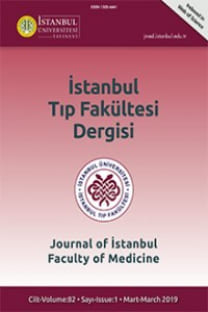VİTAMİN D EKSİKLİĞİ SIÇANLARDA ALKOLE BAĞLI OLMAYAN YAĞLI KARACİĞER HASTALIĞININ PROGRESYONUNU ARTTIRMADI
Vitamin D yetersizliği, yüksek fruktozlu diyet, alkolik olmayan karaciğer hastalığı, glikooksidatif stres, antioksidanlar, inflamasyon
VITAMIN D DEFICIENCY DID NOT AUGMENT THE PROGRESSION OF HIGH-FRUCTOSE-INDUCED NONALCOHOLIC FATTY LIVER DISEASE IN RATS
Vitamin D deficiency, high fructose diet, nonalcoholic liver disease, glycooxidative stress, antioxidant, inflammation,
___
- 1. Ibrahim MA, Kelleni M, Geddawy A. Nonalcoholic fatty liver disease: Current and potential therapies. Life Sci 2013;92(2):114-8. [CrossRef]
- 2. Fernando DH, Forbe JM, Angus PW, Herath CB. Development and progression of non-alcoholic fatty liver disease: The role of advanced glycation end products. Int J Mol Sci 2019;20(20):5037. [CrossRef]
- 3. Alwahsh SM, Gebhardt R. Dietary fructose as a risk factor for non-alcoholic fatty liver disease (NAFLD). Arch Toxicol 2017;91(4):1545-63. [CrossRef]
- 4. Takahashi Y, Soejima Y, Fukusato T. Animal models of nonalcoholic fatty liver disease/nonalcoholic steatohepatitis. World J Gastroenterol 2012;18(19):2300-8. [CrossRef]
- 5. Jegatheesan P, De Bandt JP. Fructose and NAFLD: Multifaceted aspects of fructose metabolism. Nutrients 2017;9(3):230. [CrossRef]
- 6. Gugliucci A. Formation of fructose-mediated advanced glycation end products and their roles in metabolic and inflammatory diseases. Adv Nutr 2017;8(1):54-62. [CrossRef]
- 7. Kwok RM, Torres DM, Harrison SA. Vitamin D and nonalcoholic fatty liver disease (NAFLD): Is it more than just an association? Hepatology 2013;58(3):1166-74. [CrossRef]
- 8. Uberti F, Morsanuto V, Molinari C. Vitamin D in oxidative stress and diseases. ‘A Critical Evaluation of Vitamin D-Basic Overview. Ed: Sivakumar Joghi Thatha Gowder, IntechOpen, Chapter 2, pp 47-73. 2017. [CrossRef]
- 9. Kheirouri S, Alizadeh M. Vitamin D and advanced glycation end products and their reseptors. Pharmacol Res 2020;158:104879. [CrossRef]
- 10. Khan S, Ali A, Khan S, Bakillah A, Damanhouri G, Khan A, et al. Current therapies in alleviating liver disorders and cancers with a special focus on the potential of vitamin D. Nutr Metab 2018;15:13. [CrossRef]
- 11. Eliades M, Spyrou E. Vitamin D: A new player in nonalcoholic fatty liver disease? World J Gastroenterol 2015;21(6):1718-27. [CrossRef]
- 12. Berridge MJ. Vitamin D signalling in health and disease. Biochem Biophys Res Commun 2015;460(1):53-71. [CrossRef]
- 13. Wang H, Chen W, Li D, Yin X, Zhang X, Olsen N, et al. Vitamin D and chronic diseases. Aging Dis 2017;8(3):346-53. [CrossRef]
- 14. Wimalawansa SJ. Vitamin D deficiency: Effects on oxidative stress, epigenetics, gene regulation and aging. Biology 2019;8(2):30-45. [CrossRef]
- 15. Institute of Medicine. Dietary references intakes for calcium and vitamin D. Eds: Ross AC, Taylor CL, Yaktine AL, Del Valle HB, Washington-DC, National Academies Press (US), 2011.
- 16. Elangovan H, Chahal S, Gunton JE. Vitamin D in liver disease: Current evidence and potential directions. Biochim Biophys Acta 2017;1863(4):907-16. [CrossRef]
- 17. Karatayli E, Stokes CS, Lammert F. Vitamin D in preclinical models of fatty liver disease. Anticancer Res 2020;40(1): 527-34. [CrossRef]
- 18. Rachmilewitz D, Stamler JS, Karmeli F, Mullins ME, Singel DJ, Loscalzo J, et al. “Peroxynitrite-induced rat colitis - a new model of colonic inflammation”. Gastroenterology 1993;105(6):1681-8. [CrossRef]
- 19. Wang H, Joseph JA. Quantifying cellular oxidative stress by dichlorofluorescein assay using microplate reader. Free Radic Biol Med 1999;27(5-6):612-6. [CrossRef]
- 20. Buege JA, Aust SD. Microsomal lipid peroxidation. Methods Enzymol 1978;52:302-10. [CrossRef]
- 21. Reznick AZ, Packer L. Oxidative damage to proteins: spectrophotometric method for carbonyl assay. Methods Enzymol 1994;233:357-63. [CrossRef]
- 22. Hanasand M, Omdal R, Norheim KB, Gøransson LG, Brede C, Johnson G. Improved detection of advanced oxidation protein products in plasma. Clin Chim Acta 2012;413(9- 10):901-6. [CrossRef]
- Başlangıç: 1916
- Yayıncı: İstanbul Üniversitesi Yayınevi
Selma DEMİR, Hakan GURKAN, Damla EKER, Sinem YALÇINTEPE, Emine İkbal ATLI, Engin ATLI
Ayşe SÜLEYMAN, Esra ÖZEK, Zeynep HIZLI DEMİRKALE, Sevgi SİPAHİ ÇİMEN, Cevdet ÖZDEMİR, Zeynep Ülker TAMAY, Nermin GÜLER
İNSANDA GADOLİNYUM BİRİKİMİ: RADYOLOJİ UZMANLARI VE KLİNİK UYGULAMALAR ÜZERİNDEKİ ETKİSİ
Mehmet Emin ADİN, David M YOUSEM
HİPO VE HİPERGLİSEMİNİN NADİR BİR NEDENİ; GLİKOJEN DEPO HASTALIĞI TİP 0: OLGU SUNUMU
COVID-19 HASTALARINDA MEKANİK VENTİLASYONDAN AYRILMADA TRAKEOTOMİNİN ROLÜ
Levent AYDEMİR, Hakan KARA, Cömert ŞEN, Kadir ORHAN, Meryem Nesil KELEŞ TÜREL
Serkan BAYRAM, Lezgin MERT, Mehmet EKİNCİ, Turgut AKGÜL, İrfan ÖZTÜRK
İKİ OLGU SUNUMU: İNTRAKRANİAL KANAMANIN EŞLİK ETTİĞİ COVİD-19 VAKALARI
Fatma Gül DEMİRKAN, Şeyma KARATEKİN
OKÜLT HEPATİT B VİRÜSÜNÜN GENOTİP, SUBGENOTİP VE SUBTİP ANALİZİ
Bülent ÇAKAL, Alp ATASOY, Bilger ÇAVUŞ, Aslı ÖRMECİ, Mehveş PODA, Mesut BULAKÇI, Mine GÜLLÜOĞLU, Mehmet Güven GÜNVER, Filiz AKYÜZ
Şebnem ALANYA TOSUN, Hamdullah SÖZEN, Tzevat TEFİK, Ahmet İYİBOZKURT, Yavuz SALİHOĞLU
